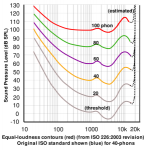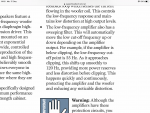It would be interesting to see compensation (not just EQ) re equal loudness contours (ie Fletcher-Munson) implemented in a truly dynamic/real-time DSP (and not being comparable to the home stereo garbage that tries to account for this)
The curves are VERY drastic in terms of human hearing of low and high frequencies across a volume range - it is ANYTHING but flat at low volumes, and gradually flattens as volume increases.

While the idea seems quite reasonable on the surface, as demonstrated by the "loudness" button on many home and car stereos, even the more recent solutions such as Dolby Volume are still too simple and don't do it justice IMO.
Sure, you can do things like dynamically boost the bass depending on volume level. But at lower levels these big compensating boosts can make the low end sound kind of disconnected and unnatural. Consumer audio makers went all-in on putting such "dynamic" features on by default in their products a few years ago, but this seems to be a declining fad lately.
Doing it "right" might be contentiously subjective, and would present quite a number of challenges to implement. As an example, how to consider for auditory masking thresholds, keeping phase linear through changes, etc.
Some of it would likely be in the realm of implementing dynamically changing FIR filters - is that even technically possible right now?
...


